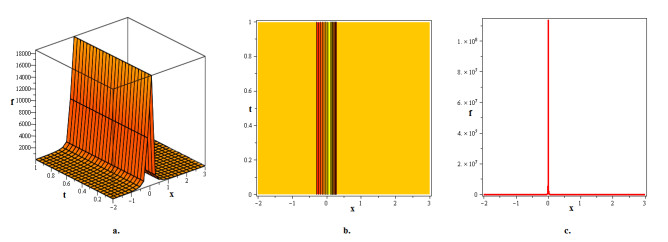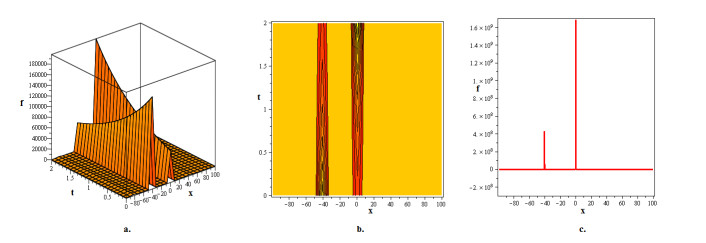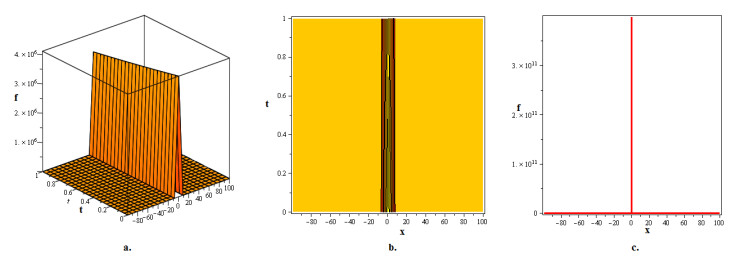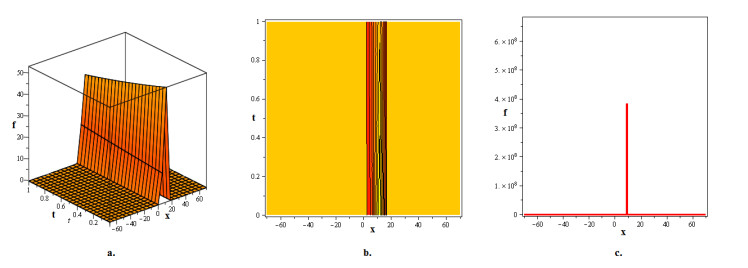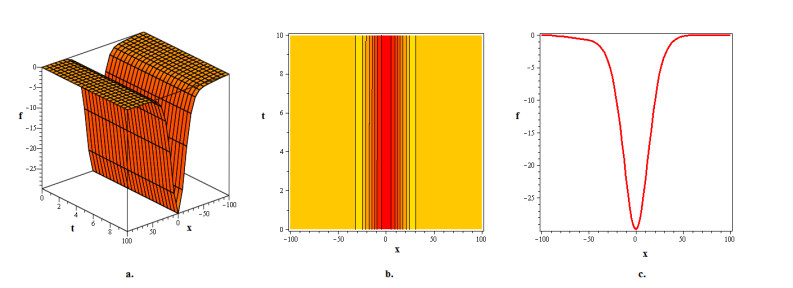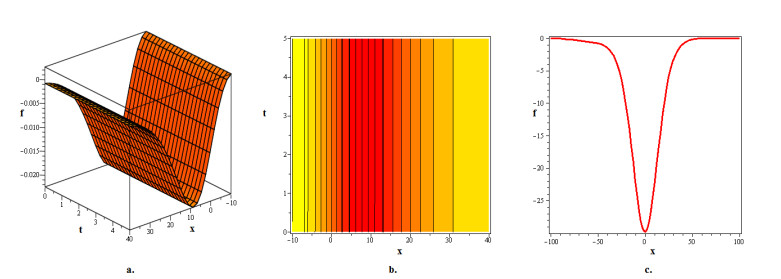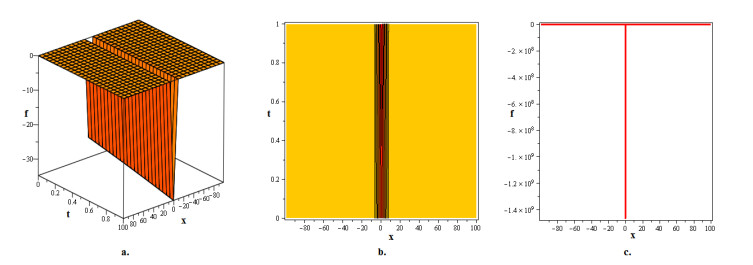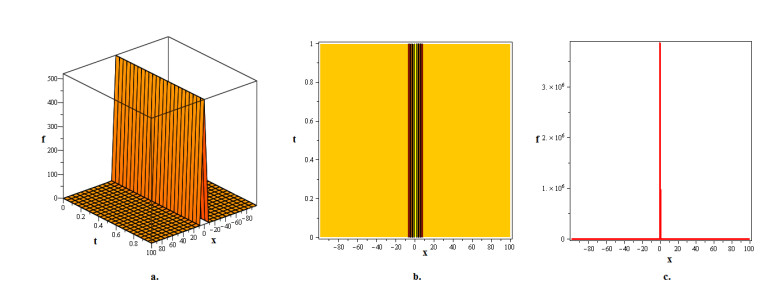1.
Introduction
The study begins by framing the targeted model inside the context of its earlier findings and providing a thorough analysis of pertinent literature. In this part, the main goals of the study are outlined, a knowledge gap is noted, and the paper's organizational structure is explained.
1.1. Overview and background of the Quintic Benney-Lin equation (QBLE)
The global ubiquity of nonlinearity highlights the need for developing nonlinear models, particularly those utilizing nonlinear partial differential equations (NPDEs) [1]. Many researchers are interested in NPDEs because of their broad variety of applications in fields including physics, biology, control, vibration, fluid dynamics, acoustics, chemistry, vibration, and image processing [2,3,4]. Scholars have devoted a lot of time and effort to the task of solving these NPDEs analytically and numerically since they have so many possible uses [5,6]. As a result, many dependable and efficient methods have been discovered by researchers because explicit solutions reveal more about the underlying structure of the nonlinear phenomena than do numerical ones, including the Kudryashov procedure [7], extended direct algebraic method (EDAM) [8,9], exp-function approach [10], modified Kather method [11], the (G'/G)-expansion procedure [12], the the residual power series technique [13], the replicated kernel technique [14], modified simple equation approach [15], the unified approach [16], first integral approach [17], modified simple equation method [18], Darboux transformation method [19], Hirota method [20] and RMESEM [21]. Nonlinear partial differential equations are crucial in modeling complex systems across various scientific fields. In this study, we apply the Riccati-Bernoulli Sub-ODE method to solve nonlinear fractional fluid dynamics equations, providing exact solutions [22,23,24,25,26]. The method offers a powerful approach to handle the nonlinearities present in fractional-order systems [27,28,29]. The recent advancements in fractional calculus, contributing to a deeper understanding of nonlinear phenomena [30,31,32].
Explicit solutions, in particular soliton solutions, have garnered significant attention lately in nonlinear scientific inquiries. The special characteristics of soliton solutions have made soliton theory more significant. These solutions are self-sustaining traveling waves known as solitons, which keep their form and speed even after colliding with other waves [33,34]. Solitons for nonlinear models have been constructed and analyzed in a number of recent papers that have been reported. Khater, for instance, used the septic-B-spline method, Adomian decomposition, and modified Kather method to produce soliton solutions for the 2D regularized long-wave problem [11]. Khater also solved the modified Korteweg-De Vries-Kadomtsev-Petviashvili (KdV-KP) equation using advanced computational techniques, producing soliton solutions [35]. Comparable soliton solutions have been constructed and analyzed using a variety of mathematical techniques, including the Gilson-Pickering equation in [36], the perturbed Chen-Lee-Liu equation in [37], rich soliton solutions for the generalized Kawahara equation in [38], the soliton solutions for the (1+1)-dimensional Mikhailov-Novikov-Wang integrable equation in [39], the soliton solutions for specific time fractional equations in shallow water waves [40], and the soliton solutions (2+1)-dimensional Ablowitz-Kaup-Newell-Segur (AKNS) equation in [41].
The goal of this work is to address a nonlinear model, namely, the Quintic Benney-Lin equation (QBLE), which describes the propagation behavior of soliton solutions in liquid films. The Benney-Lin equation (BLE) [7] was first presented by Benney [13] in 1986, and Lin subsequently refined it to analyze the effects of long waves on liquid films. This study focuses on the QBLE [14] and includes the probability density function f=f(x,t), which describes the thickness of the liquid film. The mathematical representation of the model is given as:
By giving specific values to the relevant real parameters, τ and φ, Eq (1.1) is converted into a compact, fully dissipative version of the Navier-Stokes model. This equation has been used to explain a number of phenomena, such as uneven blazing fronts, surface tension in liquid films, and spatial tiling in the Belousov-Zhabotinsky (BZ) reaction. If certain conditions are met, the equation produces the Korteweg-de Vries (KdV) equation, also referred to as the Kawahara model. For φ=0, this equation sheds light on the transmission of waves with tension on the surface in its fully dispersive state [17]. Moreover, the QBLE adopts the Kuramoto-Sivashinsky model's structure when τ=0. The waves in steep and vertically slipping films, as well as the indefinite drift patterns in plasma-which include the tension along liquid film surfaces due to nearby gas movement-are explained by this dispersive-dissipative equation. The broad applicability of the QBLE's initial value problem (IVP) in Hp(R) for p≥0 for φ=0 was shown in 1997 by Biagioni and Linares [46]. Finally, Cui et al. [47] demonstrated that for φ=0, the Kawahara model's local well-posedness is in the range of −1<p<1 to 0. Additionally, a variety of approaches have been used to address the targeted QBLE, including the reduced differential transform strategy [48], the variational iteration approach [49], EDAM [50], the residual power series procedure, and the homotopy perturbation method [51].
1.2. Research gap in the current study
Several scholars have tackled the QBLE in the direction of past study, however the dark and bright hump soliton phenomena have not been investigated and examined within the context of the intended model using RMESEM. The observation draws attention to a sizable gap in the archive of existing research. Our study offers a thorough analysis of the model and outlines the suggested RMESEM strategy with the objective to fill this gap.
1.3. Objectives and strategies of the study
In this study, we use the RMESEM to analyze and evaluate the hump soliton phenomena contained in the QBLE. The following are the strategies and aims of this study: The proposed transformation-based method converts the desired QBLE into a nonlinear ordinary differential equation (NODE) using a wave transformation. The Riccati-NODE, which presupposes a series form solution, is then included into the resultant NODE to convert it into an algebraic system of equations. This set of equations can be solved to obtain the soliton solutions in five families: the rational, trigonometric, hyperbolic, rational-hyperbolic, and exponential functional families. We apply the recently found method to generate new soliton solution abundances for the selected QBLE, therefore capturing the system's fundamental dynamics and proving its effectiveness. The presence of both brilliant and dark solitons is amply demonstrated by the methodical determination of soliton solutions. To accurately depict the studied soliton phenomena connected to these solutions, we offer 3D, contour, and 2D graphics. These visualisations help to clarify the soliton dynamics of the QBLE model and provide a comprehensive way to study the model's behavior in a liquid layer.
1.4. Layout of the present study
The rest of the article is organized as follows: Section 2 provides a detailed explanation of the proposed technique. In Section 3, we present families of hump soliton solutions for the targeted model. Section 4 includes plots of several hump soliton solutions, accompanied by discussion. Finally, Section 5 conclusions, the study and outlines future research directions.
2.
The operational procedure of the Riccati modified extended simple equation method (RMESEM)
The operational mechanism of the RMESEM is described in this section. We examine the resulting generalized NPDE:
where f=f(t,ρ1,ρ2,ρ3,…,ρr).
All steps listed below will be taken in order to solve (2.1):
(1) First, f(t,ρ1,ρ2,ρ3,…,ρr)=F(σ) is executed as a variable-form transformation. For σ, there are several representations. Equation (2.1) is transformed using this procedure to provide the following NODE:
where F′=dFdσ. The integrating equation may occasionally be used to force the NODE to follow the homogeneous balance criterion (2.2).
(2) Next, utilizing the solution of the extended Riccati-NODE, the resulting finite series-based solution for the NODE in (2.2) is proposed:
Here, P(σ) indicates the solution of the ensuing extended Riccati-NODE, and the variables kn(n=0,...,M) and sn(n=0,...,M−1) stand for the unidentified constants that need to be found later.
where λ,μ, and ν are constants.
(3) We may achieve the positive integer M needed in Eq (2.3) by homogeneously balancing the greatest nonlinear component and the highest-order derivative in Eq (2.2).
(4) Following this, all the components of P(σ) are combined into an equal ordering when (2.3) is plugged into (2.2) or the equation that emerges from the integration of (2.2). Applying this approach results in an equation in terms of P(σ). The variables kn(n=0,...,M) and sn(n=0,...,M−1) can be described by an algebraic system of equations with additional associated parameters if the coefficients in the resulting equation are set to zero.
(5) With Maple software, the system of nonlinear algebraic equations is analytically evaluated.
(6) To derive analytical soliton solutions for (2.1), the next step is to calculate and enter the unknown values alongside P(σ) (the Eq (2.4) solution) in Eq (2.3). By applying (2.4)'s solution, we might potentially derive several clusters of soliton solutions. Here is how these clusters are displayed.
3.
Establishing hump soliton solutions for the QBLE
In this section, we use our suggested method to solve the QBLE in (1.1) and produce soliton solutions. We begin with the subsequent transformation:
which converts (1.1) into the subsequent NODE:
where the derivatives of F with regard to σ are indicated by prime(s). Integrating (3.2) with respect to σ and setting the integration constant to 0 yields:
By proving that F2 and F⁗ are homogenously balanced in (3.3), we obtain M+4=2M, which yields M=4. The supposed solution for (3.3) that results from inserting M=4 in (2.3) is as follows:
We generate a set of algebraic equations by substituting (3.4) in (3.3). By addressing the resulting system, numerous solutions can be obtained, which are presented as follows:
Case 1.
Case 2.
Case 3.
Case 4.
Case 5.
Assuming Case 1, for the QBLE given in (1.1), we build the subsequent sets of hump soliton solutions:
● Trigonometric solutions: When B<0,ν≠0,
and
● Hyperbolic solutions: When B>0,ν≠0,
and
● Exponential solution: When μ=ϖ, λ=bϖ(b≠0), and ν=0,
In the above solutions, σ=x+3613Bt. Assuming Case 2, for the QBLE given in (1.1), we build the subsequent sets of hump soliton solutions:
● Trigonometric solutions: When B<0,ν≠0,
and
● Hyperbolic solutions: When B>0,ν≠0,
and
● Exponential solution: When μ=ϖ, λ=bϖ(b≠0), and ν=0,
In the above solutions,
Assuming Case 3, for the QBLE given in (1.1), we build the subsequent sets of hump soliton solutions:
● Trigonometric solutions: When B<0,ν≠0,
and
● Hyperbolic solutions: When B>0,ν≠0,
and
● Exponential solution: When μ=ϖ, λ=bϖ(b≠0) and ν=0,
● Exponential solution: When μ=ϖ, ν=bϖ(b≠0), and λ=0,
● Rational-hyperbolic solutions: When λ=0, ν≠0, and μ≠0,
and
In the above solutions, σ=x+3613Bt. Assuming Case 4, for the QBLE given in (1.1), we build the subsequent sets of hump soliton solutions:
● Trigonometric solutions: When B<0,ν≠0,
and
● Hyperbolic solutions: When B>0,ν≠0,
and
● Exponential solution: When μ=ϖ, λ=bϖ(b≠0), and ν=0,
● Exponential solution: When μ=ϖ, ν=bϖ(b≠0), and λ=0,
● Rational-hyperbolic solutions: When λ=0, ν≠0, and μ≠0,
and
In the above solutions, σ=x−3613t. Assuming Case 5, for the QBLE given in (1.1), we build the subsequent sets of hump soliton solutions:
● Trigonometric solutions: When B<0,ν≠0,
and
When B>0,ν≠0,
and
● Exponential solution: When μ=ϖ, λ=bϖ(b≠0) and ν=0,
In the above solutions, σ=x−3613Bt.
4.
Discussion
This section displays the many soliton patterns found in the model QBLE under analysis, see Figures 1–10. In contour, 3D, and 2D graphs, we were able to successfully extract and analyze these wave patterns by utilizing the RMESEM and the Maple tool. Notable characteristics of these depictions are the dark and bright hump solitons. Additionally, to the best of our knowledge, no published research has applied the proposed method to the QBLE, hence the findings of this investigation are unique.
In the framework of the QBLE, a soliton is localized and stable that maintains its speed and shape while propagating and arises in nonlinear models due to the balance of dispersion and nonlinearity's effect allowing them to propagate without any change over time. In liquid films, these solitons exhibit localized disturbance in the thickness of film which may be caused by evaporation, external forces or other dynamical processes. We prominently explored dark and bright hump solitons in the context of the QBLE in liquid film. When juxtaposed to the ambient fluid stage, dark humps can be identified by a regional submerge or decline in layer thickness that forms a void or dip. Solitons arise when the dispersive impacts outweigh the effects of nonlinearity, resulting in a regional diminution of the layer thickness of the film. These solitons reflect an expanse or decline in the vertical dimension or content of the fluid. Essentially, it suggests that the nonlinearity balances the pulling forces that propagate the wave, forming an equilibrium depression in the process. Conversely, bright humps are confined waves that develop atop the fluid's surrounding level as a crest or apex due to an unexpected rise in the amount of thickness of the film of liquid. These solitons arise because the equilibrium between dispersal and the nonlinearity permits the production of a confined spike. They are defined by an accumulation of either energy or density in a limited location, resulting in a single peak that retains its initial form when traveling across the medium's surface. This usually occurs in situations where a confined, persistent rise in layer thickness results from the nonlinearity's tendency to concentrate on the wave overpowering the dispersive effects' tendency for spreading it apart. Such behavior suggests that the mechanism is in a state of dynamic equilibrium, in which fluctuations occur on a regular basis as a result of external stimuli operating on the liquid film. We can learn about the rich behavior of the QBLE in liquid film from each of these hump solitons.
5.
Conclusions
In this work, a collection of propagating soliton solutions associated with the QBLE have been established using the strategic RMESEM. The proposed approach was effective because it yielded a greater variety of soliton solutions in the shape of rational, hyperbolic, rational-hyperbolic, and exponential trigonometric functions, which offer a deeper comprehension of the underlying dynamics of the QBLE. We have gained significant new understanding of QBLE dynamics from the dark and bright hump soliton solutions. Visual representations in two and three dimensions as well as contours aid in our comprehension of these hump soliton solutions and the related wave phenomena. As a whole, this work highlights the need for additional research and real-world applications in a number of areas, such as fluid media and plasma physics. The shortcoming of the method is that it fails when the largest nonlinear term does not balance homogeneously with the greatest derivative terms as, in this case, the homogenous balancing principle is unable to produce an algebraic system of equations. Despite this drawback, the current analysis shows that the approach used in this work is quite dependable and effective for nonlinear problems across a number of scientific fields.
The future scope of this study is to investigate the aimed model in fractional and stochastic forms and to study the effect of different fractional derivatives and noise on the soliton phenomena using the proposed RMESEM.
Author contributions
Conceptualization, W.H.; Data curation, H.Z.; Formal analysis, A.A.A; Resources, W.H.; Investigation, H.Z.; Project administration, W.H.; Validation, A.A.A.; Software, W.H.; Validation, H.Z.; Visualization, A.A.A.; Validation, W.H.; Visualization, H.Z.; Resources, A.A.A and W.H.; Project administration, A.A.A; Writing, review & editing, W.H.; Funding, W.H. All authors have read and agreed to the published version of the manuscript.
Acknowledgments
The authors gratefully acknowledge the funding of the Deanship of Graduate Studies and Scientific Research, Jazan University, Saudi Arabia, through Project Number: GSSRD-24.
Conflict of interest
The authors declare that they have no conflicts of interest.
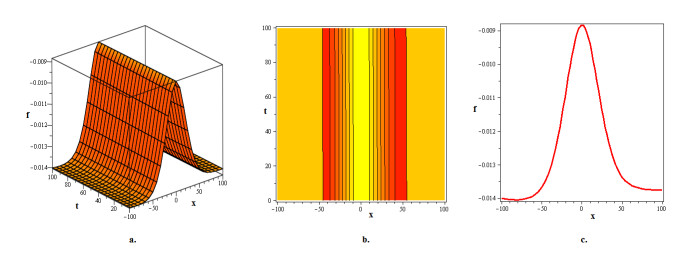









 DownLoad:
DownLoad:
